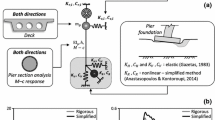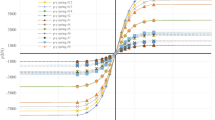Abstract
In this paper practical techniques are introduced for detailed modeling of soil–pile and soil–abutment interaction effects for integral bridges (IBs). Furthermore, a parametric study is conducted to determine appropriate structural configurations and geotechnical properties to enhance the seismic performance of IBs. For this purpose, numerous nonlinear structural models of a two-span IB including dynamic soil–bridge interaction effects are built. Nonlinear time history analyses (NTHA) of the IB models are then conducted using a set of ground motions with various intensities. In the analyses, the effect of various structural and geotechnical properties such as foundation soil stiffness, backfill compaction level, pile size and orientation, abutment height and thickness are considered. The results of NTHA are then used to assess the effects of these properties on the seismic performance of IBs in terms of member forces and deformations. It is found that while the proposed modeling techniques for IBs are easy to implement in commercially available structural analysis programs, they are also computationally efficient. However, the proposed structural model may not be used to study the soil deformations along the length of the embankment. For the IB and modeling approach under consideration, the bridge seismic response is found to be insensitive to the length of the embankment and damping of the embankment soil. Furthermore, IBs built with shorter and thinner abutments as well as large steel H-piles oriented to bend about their strong axis exhibit better seismic performance.












Similar content being viewed by others
References
AASHTO (2010) Load and resistance factor design (LRFD) specifications. AASHTO, Washington, DC
Ahn JH, Yoon JH, Kim JH, Kim SH (2011) Evaluation on the behavior of abutment–pile connection in integral abutment bridge. J Constr Steel Res 67:1134–1148
Anandarajah A, Zhang J, Ealy C (2005) Calibration of dynamic analysis methods from field test data. Soil Dyn Earthq Eng 25(7–10):763–772
API (American Petroleum Institute) (2001) Recommended practice and planning, designing, and constructing fixed offshore platforms. API, Washington DC
Arockiasamy M, Butrieng N, Sivakur M (2004) State-of-the art of integral abutment bridges: design and practice. J Bridge Eng 9(5):497–506
Bhowmick A (2003) Design and construction of integral bridges—an innovative concept. Indian Concr J 77(7):1203–1209
Boulanger RW, Curras CJ, Kutter BL, Wilson DW, Abghari A (1999) Seismic soil–pile-structure interaction experiments and analyses. J Geotech Geoenviron Eng (ASCE) 125(9):750–759
Briseghella B, Zordan T (2015) An innovative steel-concrete joint for integral abutment bridges. J Traffic Transp Eng 2(4):209–222
Cole RT, Rollins KM (2006) Passive earth pressure mobilization during cyclic loading. J Geotech Geoenviron Eng 132(9):1154–1164
Dicleli M (2007) Supplemental elastic stiffness to reduce isolator displacements for seismic-isolated bridges in near fault zones. Eng Struct 29(5):763–775
Dicleli M, Erhan S (2011) Live load distribution formulas for single-span prestressed concrete integral abutment bridge girders. J Bridge Eng 14(6):472–486
Dowell RK, Seible F, Wilson EL (1998) Pivot hysteresis model for reinforced concrete members. ACI Struct J 95(5):607–617
Duncan MJ, Chang CY (1970) Nonlinear analysis of stress and strain in soils. J Soil Mech Found Div ASCE 96(5):1629–1653
Duncan MJ, Mokwa RL (2001) Passive earth pressure: theories and tests. J Geotechn Geoenviron Eng 127(3):248–257
Erhan S (2011) Effect of vehicular and seismic loads on the performance of integral bridges. PhD thesis, Middle East Technical University, Ankara, Turkey
Faraji S, Ting JM, Crovo DS, Ernst H (2001) Nonlinear analysis of integral bridges: finite element model. J Geotech Geoenviron Eng 127(5):454–462
Fayyadh MM, Akib S, Othman I, AbdulRazak H (2011) Experimental investigation and finite element modelling of the effects of flow velocities on a skewed integral bridge. Simul Model Pract Theory 19:1795–1810
FHWA (1986) Seismic design of highway bridge foundations—volume II: design procedures and guidelines, Publication No. FHWA-RD-94-052. Federal Highway Administration, US Department of Transportation, Washington, DC
Franchin P, Pinto EP (2014) Performance-based seismic design of integral abutment bridges. Bull Earthq Eng 12:939–960
Itani AM, Sedarat H (2000) Seismic analysis and design of the AISI LRFD design examples of steel highway bridges. Report No. CEER 00-8, Center for Civil Engineering Earthquake Research, University of Nevada, Reno, NV
Jain SK, Scott RF (1989) Seismic analysis of cantilever retaining walls. In: Proceedings of structural mechanics in reactor technology (SMIRT), Anaheim, California, pp 241–246
Kalayci E, Civjan SA, Brena SF (2012) Parametric study on the thermal response of curved integral abutment bridges. Eng Struct 43:129–138
Kotsoglou A, Pantazopoulou S (2007) Bridge–embankment interaction under transverse ground excitation. Earthq Eng Struct Dyn 36:1719–1740
Kotsoglou A, Pantazopoulou S (2009) Assessment and modeling of embankment participation in the seismic response of integral abutment bridges. Bull Earthq Eng 7:343–361
Kotsoglou A, Pantazopoulou S (2010) Response simulation and seismic assessment of highway overcrossings. Earthq Eng Struct Dyn 39:991–1013
Maruri R, Petro S (2005) Integral abutments and jointless bridges (IAJB) 2004 survey summary. Federal Highway Administration (FHWA)/Constructed Facilities Center (CFC) at West Virginia University
Palemo A, Wotherspoon L, Wood J, Chapman H, Scott A, Hogan L, Kivell A, Camnasio E, Yashinsky M, Bruneau M, Chauw N (2011) Lessons learnt from 2011 Christchurch earthquakes: analysis and assessment of bridges. Bull N Z Soc Earthq Eng 44(4):319–333
Petursson H, Kerokoski O (2013) Monitoring and analysis of abutment-soil interaction of two integral bridges. J Bridge Eng 18(1):54–64
ProShake (2009) Version 1.12, EduPro Civil Systems, Inc
SAP2000 (2010) Integrated finite element analysis and design of structures. Computers and Structures Inc., Berkeley
Scott A, Civjan SA, Kalayci E, Quinn BH, Brena SF, Allen CA (2013) Observed integral abutment bridge substructure response. Eng Struct 56:1177–1191
Shamsabadi A (2007) Three-dimensional nonlinear seismic soil abutment-foundation-structure interaction analysis of skewed bridges. PhD thesis, University of Southern California, Los Angeles, CA, USA
Shirato M, Koseki J, Fukui J (2006) A new nonlinear hysteretic rule for winkler type soil–pile interaction spring that consider loading pattern dependency. Soil Found Jpn Geotechn Soc 46(2):173–188
Spyrakos C, Loannidis G (2003) Seismic behaviour of post-tensioned integral bridge including soil–structure interaction. Soil Dyn Earthq Eng 23:53–63
Takeda T, Sozen MA, Nielsen NN (1970) Reinforced concrete response to simulate earthquake. J Struct Div ASCE 96(12):2557–2573
Warn PG, Ryan KL (2012) A review of seismic isolation for buildings: historical development and research needs. Buildings 2(3):300–325
Wotherspoon LM, Bradshaw A, Green RA, Wood C, Palermo A, Cubrinovski M, Bradley BA (2011) Performance of bridges during the 2010 and 2011 Christchurch earthquakes. Seismol Res Lett 82(6):950–964
XTRACT v3.0.7. (2009) Cross-sectional X structural analysis of components. TRC/Imbsen Software Systems, Rancho Cordova
Zhang J, Makris N (2002) Kinematic response functions and dynamic stiffnesses of bridge embankments. Earthq Eng Struct Dyn 31:1933–1966
Zordan T, Briseghella B, Lanc C (2011) Parametric and pushover analyses on integral abutment bridge. Eng Struct 33(2):502–515
Author information
Authors and Affiliations
Corresponding author
Rights and permissions
About this article
Cite this article
Erhan, S., Dicleli, M. Parametric study on the effect of structural and geotechnical properties on the seismic performance of integral bridges. Bull Earthquake Eng 15, 4163–4191 (2017). https://doi.org/10.1007/s10518-017-0123-9
Received:
Accepted:
Published:
Issue Date:
DOI: https://doi.org/10.1007/s10518-017-0123-9




